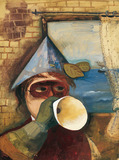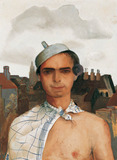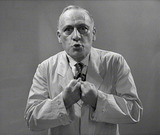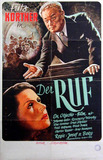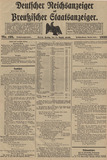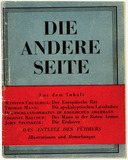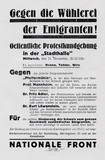Felix Nussbaum: Selbstbildnis mit Maske und Schalltrichter [ Self-Portrait with Mask and Paper Horn], painting (ca. 1936)
During his years of exile, masks took on a central role in the self-portraits of the painter Felix Nussbaum. Even before, Nussbaum had used masks as a metaphor to give expression to the two-faced character of reality.
Felix Nussbaum: Self-portrait with Tea Towel, painting (1935)
The effect of exile on one’s own facial features was the subject of a series of self-portraits by painter Felix Nussbaum which were created in front of a mirror beginning in 1936. Under the deformation of his face and the external reality laid over his face like a grimace, Nussbaum sought an inner, undisguised self.
Felix Nussbaum: Triumph des Todes (Triumph of Death), painting (1944)
The painting Triumph of Death, which is reminiscent of a medieval Dance of Death is the last known work by painter Felix Nussbaum. A torn-off calendar page on the right-hand edge of the painting provides information about the date when the painting was completed: 18 April 1944.
Film clip from Das Testament des Dr. Mabuse [The Testament of Dr. Mabuse] (1932/33)
The third of Fritz Lang’s films about the genius criminal Dr. Mabuse was also his last German directorial work before the Second World War.
Film clip from Der Kongress tanzt [The Congress Dances] (1931)
During the Vienna Congress, at which European ambassadors are negotiating the realignment of the continent, not only Prince Metternich (Conrad Veidt) has his own agenda; glovemaker Christel (Lilian Harvey) also has an ambitious strategy for selling her gloves. But then she falls in love with the Russian Czar Alexander (Willy Fritsch), who has her picked up in his coach and taken to a villa.
Film clip from Der Ruf [The Last Illusion] by Fritz Kortner
Under the direction of Josef von Bákys and based on the screenplay by Fritz Kortner, the remigration film Der Ruf was made in 1948/1949. Kortner's own experiences undoubtedly flowed into this work and make the film a personal document of the exiled actor.
Film poster for Der Ruf [The Last Illusion] (1949)
After his return from exile in the US, actor Fritz Kortner wrote the screenplay for this semi-autobiographical film: a film document of German remigration.After 15 years of exile in the US, Professor Mauthner returns to Germany against all reservations expressed by his fellow exiles.
First Expatriation List, 1933
The “Gesetz über den Widerruf von Einbürgerungen und die Aberkennung der deutschen Staatsbürgerschaft” [Law regarding the revocation of naturalization and the deprivation of German citizenship] came into force on 14 July 1933, allowing the Nazi regime to immediately revoke the citizenship of many “unwanted” individuals and thus make them stateless.
Flier brochure Die andere Seite [The other side] (Number 3, 1943)
The pamphlet Die andere Seite was published from 1942 by British war propaganda in collaboration with German emigrants. Four issues appeared by the end of 1943.
Flyer for a protest rally against the Pfeffermühle (1934)
Riots broke out during the November 1934 Pfeffermühle performances in Zurich. The third exile show, which had premiered a month before in Basel, had become significantly more barbed.
